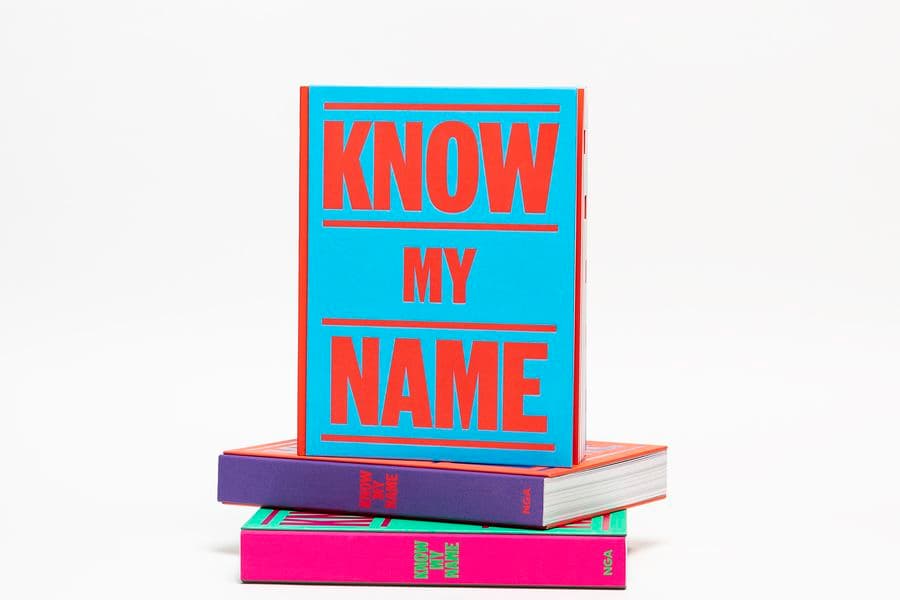Bronwyn Oliver
Born 1959 (Inverell, New South Wales); Died 2006 (Gadigal land/Sydney)
Bronwyn Oliver by Hannah Fink
Excerpted from the Know My Name publication (2020).
If creating a unique language of form is the mark of a great sculptor, there is no question that, along with Robert Klippel and Clement Meadmore, Bronwyn Oliver is one of Australia’s greatest sculptors. That she has not been heralded as such is strange, and one can only deduce that—despite one’s disbelief that it could be so—it is because her work is so resolutely female.
Oliver worked in families of form—the egg, sphere, spiral, meander—predominantly in copper, and Trace, executed in 2001 at the height of her career, is the exemplar of its kind. She was intrigued by the automaticity of handwriting, the point at which practice becomes haptic:
In forming letters to make words the pen rises and falls against the paper in a rhythm relating to the meaning of the words and the mind of the writer … The three‑dimensional form of the sculpture rises and falls against the wall—sometimes narrowing, sometimes swelling, sometimes overlapping or curling back on itself, but always in a continuous movement as if flowing from an unseen ‘hand’.(1)
An expert knitter and dressmaker, Oliver would think nothing of cutting out and sewing a complicated garment after a long day in the studio. ‘All that boofy bloke stuff,’ she once said, meaning soldering and welding and brazing, ‘is just stitching and sewing’.(2) Equally, making patterns, being able to think in the inverse and in three dimensions, occurs in the space where physics are imagined. In Trace, Oliver sets up a dynamic between the three‑dimensionality of the embodiment of the calligraphy and the elastic two‑dimensionality of the shadow it throws.
I try to draw attention to the inside space in my work. I try to energise the emptiness. The outside of the work is a description of the potential in the emptiness inside them. The shadow compresses the emptiness.(3)
Trace exemplifies Oliver’s ambition as an artist. She once likened her work to a Bach fugue, ‘something formal with life’, and just as the calligraphy of music is brought to life through hand and throat, so the sculptor realised her art in the human touch.(4)
It is this vibration, this tremolo, that Oliver sought to strike: to capture through the arduous and sometimes painful process of twisting and brazing wires (her hands often bled) the eloquence of gesture. It is possible that spiders think through their webs, that their silk geometries operate as sentient extensions of their bodies. Like Arachne, like Goethe’s Gretchen am spinnrade, Oliver became trapped in the vortex of her making, imprisoned by her own virtuosity. But here, the tryst between idea and object, material and human hand, ‘sings with rightness’.(5) In most hands a flourish is decorative; in the hands of a great artist it is the height of expressiveness, the signature of absolute creative freedom.
(1) Bronwyn Oliver quoted in National Sculpture Prize & Exhibition 2001, National Gallery of Australia, Canberra, 2001, p 68.
(2) Oliver, interview with Hannah Fink, 1999.
(3) Oliver, interview with Max Cullen, Sunday, ABC TV, 1993.
(4) As above.
(5) Oliver, artist statement, quoted in Felicity Fenner, Bronwyn Oliver, Moet & Chandon, Epernay, 1995.
Citation: Cite this excerpt as: Fink, Hannah. "Bronwyn Oliver" in N Bullock, K Cole, D Hart & E Pitt (eds), Know My Name, National Gallery of Australia, Canberra, 2020, pp 284–285.
Image caption: Bronwyn Oliver, Trace, 2001, copper wire, 30.0 x 245.0 x 15 cm, National Gallery of Australia, Canberra, purchased 2002.
HANNAH FINK is a former editor of ArtAsiaPacific and Art and Australia magazines and the author of Bronwyn Oliver: Strange things (2017).
//know-my-name/media/dd/images/64184.ba24299.jpg)
